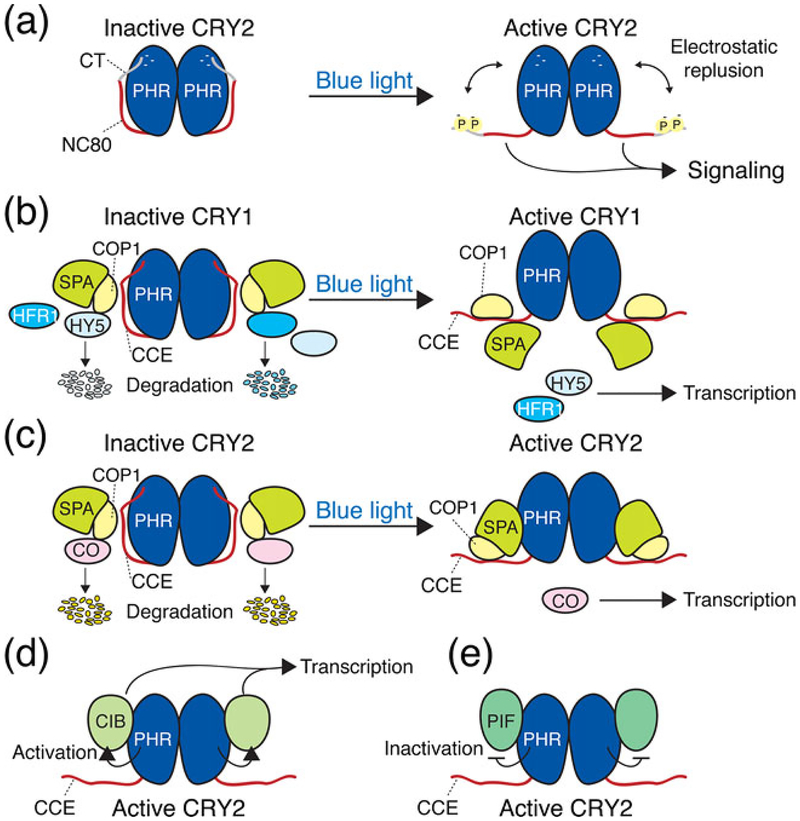Figure 2.
Hypothetical models depicting a blue light-induced CRY conformational change and CRY signal transduction mechanisms in Arabidopsis. (a) CRYs consist of two domains, the PHR domain and the CCE domain, and they form homodimers via the PHR domains. In the dark, CRYs have a closed conformation. Upon blue light activation, CRYs undergo conformational changes, mostly in CCE domains, to transduce signals to downstream components. Blue light-induced phosphorylation at multiple sites of the C-terminal tail in the CCE domain generates negative charges (–) at these sites, resulting in the electrostatic repulsion of the NC80 domain from the PHR domain, which induces a CRY signaling relay to the downstream components. (b, c) Models depicting how CRY1 and CRY2 regulate the E3 ubiquitin ligase activity of the COP1/SPA complex. In the dark, COP1 and SPA constitute an active complex that promotes the degradation of transcription factors, such as HY5 and CO, which are positive regulators of de-etiolation and flowering, respectively. In blue light, photoactivated CRY1 binds to SPA and dissociates COP1 from SPA1 on the CCE domain. This active CRY1-mediated dissociation inactivates the COP1/SPA complex, and therefore, HY5 accumulates to promote de-etiolation. Unlike CRY1, the blue light-induced interaction between CRY2 and SPA via the PHR domain does not dissociate the COP1/SPA complex but enhances the interaction between CRY2 and COP1. This enhanced connection between CRY2 and COP1 may inactivate the COP1/SPA complex to promote CO accumulation and subsequent FT expression and flowering. (d, e) Model depicting how CRYs regulate the activity of bHLH transcription factors. Blue light-activated CRY2 binds to CIBs via the PHR domain to positively regulate the activity of CIBs, leading to FT expression and subsequent flowering. Photoactivated CRY1 and CRY2 bind to PIFs to inactivate them. The CRY2 PHR domain interacts with PIF5, but the PIF-binding domain of CRY1 has not been mapped yet. The exact mechanism by which CRY binds to CIBs or PIFs to regulate their transcriptional activity remains unknown. CCE, cryptochrome C-terminal extension; CIB, CRY-interacting basic helix–loop–helix; CO, CON-STANS; COP1, CONSTITUTIVE PHOTOMORPHOGENIC 1; CT, C-terminal tail; FT, FLOWERING LOCUS T; HY5, LONG HYPOCOTYL 5; NC80, 80 residues without C-terminal tail in CCE domain; PHR, photolyase-homologous region; PIF, PHYTOCHROME-INTERACTING FACTOR; SPA, SUPPRESSOR OF PHYA-105.

